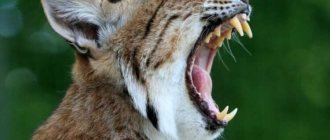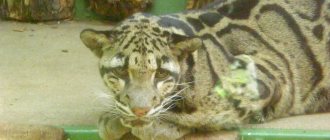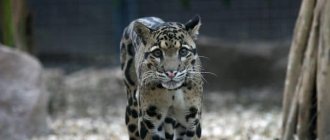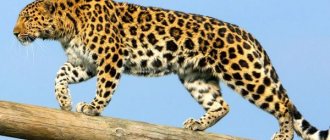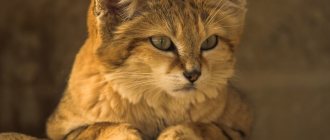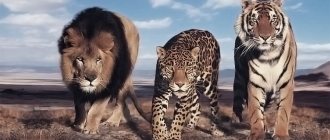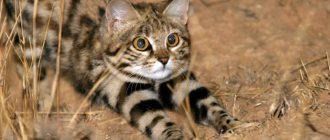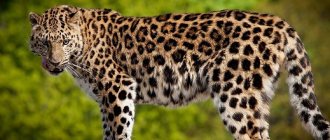One of the most colorful, graceful, majestic and cunning animals of the cat family is the leopard. He is very careful and fast, he is distinguished by a strong, muscular, strong body and keen eyesight. Leopards see perfectly in any light, and their claws and teeth are amazingly sharp. But the most important distinguishing feature of this type of predator, which also serves as an excellent means of camouflage, is its coloring. The leopard's spotted fur is predominantly white, black and brown. Now leopards are listed in the Red Book as an endangered species that is protected.
Description of the leopard
Leopards are large cats, but they are smaller than tigers and lions.
They have an elongated, muscular body, slightly compressed from the sides, light and slender, very flexible, with a long tail. The limbs are short, strong, with powerful and wide front paws. The head is small, round in shape with a convex forehead, small ears, rounded, set wide. The eyes are small. There is no mane or elongated hair on the neck and cheeks. Vibrissae are black and white, up to 110 mm in length. — Advertising —
The body size and weight of a leopard depends on the region where it lives: forest dwellers are usually smaller and lighter. The body length is 90-190 cm, the tail is 60-110 cm long. Females weigh from 32 to 65 kg, males - from 60 to 75 kg. The height of males is 50-78 cm, in females it does not exceed 45 cm.
The coat is short, close-lying, coarse and dense. Summer and winter fur have virtually no differences, the latter is slightly paler and duller. The main color background is yellow or red-yellow with small black spots that form rings with light centers.
Appearance
The leopard is a large cat that is second in size only to the lion and the tiger . The leopard's body is muscular and elongated, but at the same time light and elastic. The length of the animal's tail is more than half the size of its body. The animal's legs are small, but at the same time very strong. The paws are massive and wide, and the head has a rounded shape and is not large in size. The top of the leopard's head is decorated with short, rounded ears that are spaced wide apart.
This animal has small eyes with round pupils. There is no mane, the whiskers are white or black and reach a size of 120 mm. As for how much a leopard weighs, these indicators differ depending on the geographical area of residence. Animals that live in wooded areas have smaller body weight and size than their counterparts that live in open areas. Males of these cats, as a rule, exceed the size of females by a quarter. The length of an adult leopard can vary in the range of 85-200 cm. The tail can reach a length of 55-80 cm.
Leopard color features:
- The fur of an adult is not fluffy and short (even in winter), and is distributed evenly throughout the body. Yellow and black hair have different thicknesses and lengths. As a rule, yellow hair is longer and thinner, unlike black hair.
- Fur in winter is duller than in summer.
- The paws and belly of the leopard, as a rule, have solid dark spots. On the outside of the legs on the upper part of the body they are larger, and closer to the bottom the spots become smaller - the leopard’s feet and hands are marked only with small dark specks.
- The tail of the animal is covered with large solid and ring spots - from the upper part and slightly from the bottom.
Leopard feeding habits
The main favorite food of leopards is roe deer, deer, and antelope.
Predators watch their victims near bodies of water, then jump and cling to the neck, killing the prey. Then they hide the carcass high in the trees, lifting up even the bodies of animals three times larger than themselves. If there are not enough ungulates, then the leopard hunts hare, birds and even monkeys. Can feed on carrion. In general, the leopard’s diet helps cleanse the environment of weak animals, that is, it is a kind of natural selection. Leopards often steal each other's prey from trees, as it can remain there for 2 to 7 days, depending on how hungry the predator that caught it is.
Feeding leopards
As a rule, the leopard's diet consists of ungulates - roe deer, deer and antelope. Sometimes it can feed on monkeys and rodents, as well as snakes and birds. Can hunt horses and sheep. Dogs, as well as wolves and foxes, often suffer from leopards. For lack of food, an animal sometimes steals prey from its relatives. As for humans, predators rarely attack people - to do this it is necessary to disturb the leopard. But he will certainly attack if he is wounded - in this case the consequences will be very sad.
Leopard distribution
— Advertising —
Leopards are common in Africa and Asia, in the north of the Caucasus Mountains and in the Amur taiga. For life they choose savannas, mixed forests and mountain slopes.
In general, these predators adapt well to any environment. So, on the African continent they live in jungles, savannas, semi-deserts and mountains. But coniferous and dense tropical and subtropical mixed forests of Asia are also becoming an acceptable habitat for them.
Where do leopards live?
Leopards live over a vast territory - in Africa (except the Sahara), in central and southern Asia (Nepal, India, Bangladesh, Bhutan, Pakistan, Sri Lanka), as well as in northern India, southern China and the Korean Peninsula. In Russia, this predator can be found in the Caucasus and Primorye. Of the entire cat family, the leopard has the largest habitat.
The animal's natural habitat is dense tropical, subtropical and mixed forests, savannas and plains, mountain slopes, and thickets along river banks. Leopards live successfully both in warm tropical conditions and in northern deciduous and coniferous forests. They are practically not found in deserts and arid areas.
Predators usually live alone and have their own territory. The area of one's own territory depends on the biomass density, that is, on the amount of potential prey, and on the terrain. In arid regions with low biomass density, the size of an animal's own territory will be several times larger than in a forest or mountainous area. Predators with large territories often have cross-territories with their neighbors. Females often share their territory with their female offspring, but older males usually move away from their mother's territory.
Common Leopard Species
For the leopard, the following subspecies are distinguished depending on the regions of their habitat:
- African leopard (Panthera pardus pardus) in Africa
- Indochinese leopard (Panthera pardus delacouri) in Indochina
- Javan leopard (Panthera pardus melas) on acute Java
- Indian leopard (Panthera pardus fusca) in India, southeast Pakistan, Nepal
- Ceylon leopard (Panthera pardus kotiya) in Ceylon
- North China leopard (Panthera pardus japonensis) in China
- Far Eastern leopard (Panthera pardus orientalis) in the Far East, northern China, Korea
- Persian leopard (Panthera pardus saxicolor) in Western Asia and the Caucasus
- South Arabian leopard (Panthera pardus nimr) on the Arabian Peninsula.
Jaguar and leopard, such similar and different spotted “seals”
Jaguar and leopard.
such similar and different spotted “seals”. In a comment under my post about snow leopards, one of the “gossip girls” suggested that I continue writing about animals, including big cats. I thought about it and decided that yes, . Perhaps I’m interested in this and I have enough inspiration for several such posts. I love big cats dearly, although I also like domestic kitties. But big wild cats evoke special emotions, their beauty and grace are so unique that it is difficult to find animals equal to them in nature.
My post today is about jaguars and leopards, cats that are similar in appearance, but significantly different in lifestyle and behavior.
To be honest, sometimes it’s quite difficult to distinguish them and you have to look closely at them for a long time and figure out who is who.
So, jaguar and leopard belong to the family of big cats, panthers. These species are closely related. In addition to jaguars and leopards, the big cat family includes tigers and lions. The jaguar is the third largest cat in the world, second only to lions and tigers. On average, the weight of a jaguar is 60-90 kg; there are rarely large jaguars weighing up to 120 kg. The record weight of a jaguar in nature is 158 kg. Females are 20 percent lighter than males. A leopard is smaller than a jaguar, the average weight of a male is 65-75 kg. Females 32-60 kg.
How to distinguish them externally? There are jokes that you can just read the sign at the zoo; another sure way to distinguish one from another is considered to be a geographical feature. If it happens in America, then a jaguar, if in Asia and Africa, then a leopard.
Jaguar.
Leopard.
Leopards and jaguars differ in appearance, geography and behavior. Let's start with the appearance and try to figure out these cats. As I wrote above, a jaguar is larger than a leopard. The physique is more powerful, stocky, the tail of the jaguar is shorter. And the leopard has a stylish tail that is long in relation to the length of its body. Cats differ noticeably in the shape of their muzzle. In a Jaguar it is elongated, in a leopard it is flattened.
The color varies if you look closely. A leopard has smaller spots and more of them. The jaguar is larger and has small dark spots in the middle of the rosettes. And the color itself, in general, is lighter in the leopard. The jaguar's color is darker, redder, and richer.
Among jaguars and leopards there are melanistic, black individuals. This is also a distinctive feature of these particular species; other big cats do not have melanism. It is even more difficult to distinguish black individuals; where is the leopard, where is the jaguar, try to figure it out. But the color can no longer be distinguished, so you need to look at the build and shape of the muzzle, the length of the tail.
Jaguar is melanistic.
The leopard is melanistic.
But the habitats of our cats are completely different and do not overlap. Jaguars are an American species. they inhabit South, Central and southern North America. Currently, the habitat of jaguars has been reduced by a third of its former size due to conflict with humans. In nature, no one threatens the jaguar; the jaguar is the top predator of the ecosystem. The preferred habitat for jaguars is tropical rain forests. But it is also found in grasslands, in areas overgrown with xerophytic shrubs, in mountain forests at an altitude of up to 2000 meters and on the ocean coast.
The leopard lives in Asia and Africa, its range is very wide. Only the domestic cat has a wider habitat. Leopards inhabit sub-Saharan Africa, the Far East, Indochina, Hindustan, and eastern Africa. the outskirts of Tibet, Afghanistan, Malaysia. Java, Pakistan, Iran, Asia Minor and the Arabian Peninsula. There are different subspecies of leopard, they are distinguished depending on the habitat of the seals. Far Eastern, Indian, African, Central Asian, South Arabian, etc. The South Arabian leopard is considered the smallest in size. The leopard lives in tropical rainforests, temperate coniferous forests, savannas and semi-deserts, subtropical and mixed forests on mountain slopes in India and southeast Asia. The leopard avoids desert areas with a very dry climate. In some habitats, the leopard is the ecosystem's apex predator. In others (Hindustan, South and East Africa), its range overlaps with tigers and lions, which occupy the top position in the food chain and are the leopard’s natural enemies.
African leopard.
Far Eastern leopard.
Central Asian leopard.
There are many similarities in the behavior and lifestyle of jaguars, but there are also significant differences.
Let's start with the similarities. Both types of cats lead a solitary lifestyle, meeting with relatives only during the mating period. Males sometimes fight over females, but this is not a common occurrence. Sometimes there are clashes over territory. Females rarely quarrel; they simply try not to intersect with each other. The female raises the kittens alone, protecting them from males, since males can kill the kittens so that the female becomes ready to mate and reproduce again.
Jaguars and leopards hunt from ambush, like most cats, sneaking up on prey, attacking unexpectedly and quickly killing by strangulation. Although jaguars have their own signature method of killing prey. They deliver a powerful bite and pierce the victim's skull. It should be noted that jaguars have a very powerful jaw. They easily chew turtle shells.
The main differences between jaguars and leopards in their lifestyle is that jaguars love water very much and have a lot to do with water. They often hunt aquatic animals such as caimans and sea turtles, which they stalk on the shore when they lay eggs. Hunting for capybaras and tapirs also often takes place in the water. Jaguars also fish.
Leopards are wary of water, like most cats, especially African leopards, as Nile crocodiles can easily kill and eat a leopard. If the jaguar can be called an aquatic cat, then the leopard is rightfully considered a steeplejack cat; it spends a lot of time in the trees, often hiding prey there. This behavior is especially characteristic of leopards in Africa, living next to lions and hyenas, who never miss an opportunity to take prey. Leopards also hunt in trees, attacking monkeys. Usually they do this at night. When monkeys see poorly.
Do jaguars and leopards hunt people? Cases of jaguars attacking people are rare; it is safe to say that the jaguar does not consider humans as prey.
It's more difficult with leopards. Among them there are cannibals. For some reason, this phenomenon is most widespread in India. Scientists believe that the reason for this is the reduction in the amount of food and the settlement of people in places that were previously hunting grounds for leopards. People often become victims of leopard attacks when going to the forest to use the toilet; as we know, India has a big problem with toilets. And millions of rural residents go to “nature” to relieve themselves. Adults often manage to fight off a leopard, but children usually die if no one has time to come to their aid.
Separately, it should be noted that leopards live on the territory of the Russian Federation. Today, the population of Far Eastern leopards is gradually growing, and today there are 110 individuals.
There is a program for returning leopards to the Caucasus. After all, they used to live there, but were completely exterminated. A special introduction program involves the release of captive-bred leopards into the wild after special training. Now the program is working, it’s too early to talk about the results, time will tell.
At the end I will write a little about jaguars and leopards in captivity. Of course, they are in zoos, the jaguar is a Red Book animal, and it is recognized that it is under threat of destruction. Jaguars are not usually found among private owners precisely because of their rarity. But leopards often end up in rehabilitation centers from photographers and careless private owners. As far as I understand, in captivity these cats do not breed very actively and there is no surplus of these cats in zoos.
Since jaguars and leopards are solitary in their way of life, it is believed that living in captivity they are unlikely to be able to build a trusting relationship with a person and become “tame.” This is probably a correct opinion, but anything can happen, a long time ago I watched a program on Animal Planet about a Mexican who has a female jaguar at home. He is rich and has excellent conditions for a cat, a wonderful house with everything necessary, so his jaguar was very sociable, he even took her to the park for a walk on a leash.
At the end, to lift your spirits, I will attach a link to a video from the Primorsky Safari Park, the Far Eastern leopard Rona in all its glory.
I hope that my post will be of some use and that those who are a little confused about big spotted cats will find it easier to understand which one is a jaguar and which one is a leopard. And, of course, look at the pictures and admire the beauty.
Leopard behavior
Leopards usually lead a solitary lifestyle, except during the mating season.
Like many other predators, they are nocturnal. During the day they climb trees, where they rest quietly, and at dusk they go out hunting. Leopards are good steeplejacks and can easily jump onto trees or rocks up to 5 meters high. Leopards are distinguished by acute vision and keen hearing. Even in pitch darkness they can navigate perfectly. And their ideal protective color helps predators camouflage. This is why even experienced hunters often miss leopards. Their location is usually revealed by a long tail, which they cannot tuck, and if the animal is excited, the tail moves, which also attracts attention.
Leopards are the main threat to monkeys. The latter, when they notice a predator, try to climb as high as possible into the trees and begin to scream loudly. Even large baboons avoid meeting a leopard.
These cats very rarely attack humans, only if they are injured or provoked.
Description, character and features of the leopard
Leopards hate water and rain. In rainy weather they hide and wait. Predators have excellent hearing and vision, but their sense of smell is rather weak. They have an excellent reaction - in speed and swiftness, leopards are superior to tigers and lions, although they are inferior to them in size. They can make a wide range of sounds - purring, hissing, growling, coughing, hoarse screams.
The leopard is an excellent tree climber, so it often hides prey in branches and sleeps mainly in trees. Their spotted color helps them successfully hide in foliage and grass. Leopards are able to sneak up on prey at a very close distance even in short grass up to 30-40 cm high; they are a perfect predator, fast and silent.
Capable of dragging a carcass twice its own weight, and can drag it up a tree. Predators reach a maximum speed of up to 60 km/h and have a powerful jump - they can jump up to 3 meters in height and up to 6 meters in length. The animal's favorite method of hunting is to jump onto the back of the prey from an ambush from a height of 5-6 meters and grab the prey by the scruff of the neck.
Leopard breeding
In the south of its range, the leopard breeds throughout the year.
In the Far East, mating season occurs in late autumn or early winter. At this time, fights often occur among the males; they roar loudly, although they usually behave very silently and quietly. Pregnancy lasts 3 months, after which 1-2, sometimes 3 blind babies are born. Females choose caves, crevices, and holes in remote, secluded places as dens. At the age of 2.5 years, the young leopard reaches the size of adults and becomes sexually mature, moving on to independent life.
Reproduction
Female and male leopards can have a large number of partners. The urine of females contains a certain pheromone that attracts males. Walking in front of the male, the female attracts the attention of a possible partner.
Mating occurs within 3 seconds, with a six-minute pause between copulations. A pair can mate about a hundred times a day. The breeding process occurs throughout the year, with the greatest activity in May.
The duration of estrus in females lasts for a week with a cycle of 46 days. Gestation of the cub lasts 96 days. When they reach the age of nine, they stop producing offspring.
The eyes of a newly born leopard open only a week after birth. The baby's weight is about 1 kg. Having reached two weeks of age, kittens begin to walk, and at 6-8 weeks they eat solid food.
The mother gives a third of the total amount of prey to the cub. Breastfeeding stops at 3 months of age, and independent life begins upon reaching 20 months.
Natural enemies of the leopard
Agile, secretive and strong, adult leopards have virtually no enemies.
Their food competitors are the lion, hyena, and tiger, which can steal prey that leopards hide in the trees. In recent years, the leopard population has been steadily decreasing. The main threat to them was human activity: hunting, destruction of natural habitats, reduction of food supply. Previously, leopards were hunted for the purpose of obtaining their valuable and beautiful skins, but now poaching is associated mainly with the needs of oriental medicine. For example, at the beginning of the 21st century, the number of individuals of Far Eastern leopards was only about 50. Five subspecies of leopard, including the Far Eastern one, are included in the IUCN and Russian Red List. Hunting them is prohibited.
Population and species status
Scientists have noted a steady decline in the total number of leopards in the wild. The main factors that have a negative impact on the populations of these predators are human activity, which leads to a reduction in the food supply. The Javan leopard subspecies inhabiting the island of Java is on the verge of complete extinction.
The Ceylon leopard may face the same fate if serious steps are not taken to restore its numbers. The East Siberian leopard, the Central Asian and South Arabian leopards should be classified as an endangered species.
Interesting facts about the leopard:
- As among lions and tigers, among leopards, although extremely rare, there are cannibals; old or sick animals that are unable to hunt ungulates. In the 20s of the last century, the “Rudraprayag cannibal” became widely known in India. He killed 125 people, sneaking into villages and people's homes at night. Leopards also begin to attack people after being injured by porcupine quills. In such cases, the animal becomes crippled, loses mobility, and begins to attack humans, since it cannot fully hunt ungulates.
- Leopards are a symbol of cruelty, ferocity, aggression, and fearlessness. Since the spots of this predator are similar to eyes, it is called the Vigilant Guardian. The Chinese consider leopards to be a symbol of courage and warlike ferocity. In Ancient Egypt it was associated with the supreme god Osiris, and among the Greeks with Dionysus.
Cheetah and leopard - what's the difference?
Many people confuse the cheetah and the leopard. In fact, these are different animals.
- Biologically, they belong to different genera: the cheetah is separated into a separate genus of cheetahs, and the leopard belongs to the genus Panthera.
- Cheetahs are easy to distinguish externally - on their muzzle they have black stripes from the corners of the eyes to the mouth, a kind of black tear tracks.
- The cheetah runs much faster than the leopard, but cannot climb trees like the leopard.
- The cheetah has longer legs and a narrow body adapted for running.
- Cheetahs are excellent sprinters and catch up with their prey, while leopards, on the contrary, quietly sneak up and attack from ambush.
- Cheetahs have ruffled, protruding fur, while leopards have smooth fur.
- A leopard can hide its claws, but a cheetah cannot.
- Leopards have large and regular-shaped spots on their skin, while cheetahs have smaller spots and different shapes.
7._samec_ahun._foto_u._semyonova.jpg
Male Akhun.
Photo: Umar Semyonov Behavior and lifestyle: The leopard walks a lot, covering considerable distances. Being a conservative animal, he always prefers to move along the same paths. Each animal has its own territory, which it constantly marks - leaving “tears” on the trees, marks on the ground and stones. The leopard fiercely guards its lands, and if a stranger is found on them, the matter will most likely end in a bloody fight, or even the death of one of the predators. These animals are loners; you can see two leopards at the same time either during the mating period, or if the predators are still young and have not had time to acquire their own hunting grounds. Leopards are the largest cats that can climb trees, where they like to rest during the day.
But these predators prefer to hunt on the ground, quietly creeping up to the prey within a jumping distance. Sometimes there were cases when the leopard deliberately “stomped” its paws and then became silent in order to confuse the prey, which in this case did not understand where to expect the attack. When hunting in rocky areas, spotted cats use rocks as cover and can spend a lot of time in ambush, and before the final attack, climb onto a pile of stones to jump on top of the prey. The predator is capable of killing prey several times heavier than itself—the wapiti included in the leopard’s diet can weigh half a ton. It is impossible to eat such an amount of meat at once, and in order to protect the remains of prey from other predators, the leopard sometimes drags them up a tree.
Leopard is the most mysterious cat
Leopards are the most mysterious of all big cats. These animals are so careful and vigilant that even in nature reserves it is difficult to track their lifestyle.
Baby leopard plays in the zoo.
The fur color of these predators helps them hide in the foliage of trees and grass and makes leopards almost invisible. There are also black specimens.
Black leopard, panther
The black coloration of panthers is a manifestation of melanism caused by a gene mutation and is characteristic only of females, with rare exceptions. The fur of a black panther is not perfectly black; it always shows visible spots to a greater or lesser extent.
Etymology and names
In ancient times, there was an opinion that the leopard was nothing more than a hybrid of a panther and a lion. It was this assumption that resulted in the name of the animal, combining two Greek words: leōn (which means “lion”) and pardos (which means “panther”). Modern scientists attribute the appearance of the name Panthera pardus to its origin in Latin via the Greek pánthēr. They also believe that the modern name of the leopard comes from the word of Indo-Iranian origin “pandarab”. It means "pale yellow" and was later borrowed into Greek.
The origin of the species name "leopard" originates in the Khatti language (which is a possible ancestor of the Adyghe and Abkhaz languages). The word prassun has also been found in Russian literary language since the 16th century. Initially, the name referred directly to the Caucasian leopards - Panthera pardus. Among the rangers of the Caucasus Nature Reserve in the 19th century, the word “pantiere” was used, the origin of which is attributed to the era of noble hunts. Russian zoologists also used the word “leopard” back in the 18th and 19th centuries.
Leopard hybrids
Among leopards there are hybrids - such as leopon. Leopon is a hybrid resulting from crossing a male leopard with a female lion. The existence of Leopon was first officially confirmed in Kolhapur in India at the beginning of the 20th century. Later they began to be deliberately bred in zoos in Germany, Japan and Italy. Leopard hybrids cannot bear offspring. The appearance of the leopon is also quite interesting. Its head is shaped more like a lion's. All other parts of the hybrid's body are more similar to the body of a leopard. The size of the hybrids is usually somewhere between a lion and a leopard. Male hybrids sometimes have a mane similar to a lion's, which can reach 20 cm in length. The color of leopons is distinguished by brown or black spots, and their tail is decorated with a lion's tassel at the end.
Another leopard hybrid is the berry pard - it appeared after crossing a male jaguar and a female leopard.
Reproduction and lifespan
It is interesting to watch these animals during the rut. Each male tries to win the most beautiful female and prove that he is the one worthy of her. This is determined by their fights and competitions with each other.
As soon as their breeding season arrives, leopards that prefer solitude take off. The den is landscaped by the female. She chooses a place away from prying eyes in crevices, caves or holes under trees.
The female's pregnancy lasts approximately 90 – 110 days. After this, from one to three babies are born, who are completely blind and helpless. They can be spotted or pure black, depending on the presence of pigment.
Only the female raises the babies, but the male is always next to them. Young leopards live with a female from 1 to 1.5 years. During this time, she manages to put them on strong paws and teach them all the tricks of their habitat.
When they reach 30 months, leopards leave their parents' den and begin to lead an independent lifestyle. Animals from the Red Book, the leopard , is one of the most interesting wonders of nature, which we, people, need to preserve at all costs.
